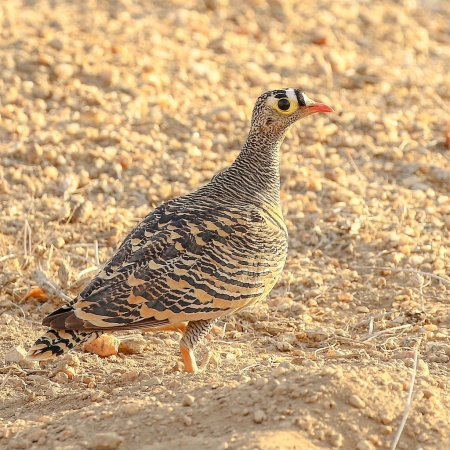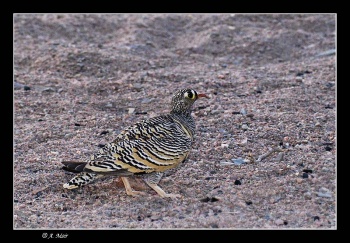m (→External Links: removed BFTV link) |
|||
| (7 intermediate revisions by 4 users not shown) | |||
| Line 1: | Line 1: | ||
| − | + | [[Image:S64A5625-2.jpg|thumb|450px|right|Subspecies ''sukensis''<br />Photo by {{user|max1|max1}}<br />Sera conservancy, North [[Kenya]], September 2017]] | |
| − | + | ;[[:Category:Pterocles|Pterocles]] lichtensteinii | |
| − | [[Image: | ||
| − | |||
==Identification== | ==Identification== | ||
| − | + | 22–26 cm (8½-10¼ in) | |
| − | + | *Buff body feathering barred black<br /> | |
| − | + | '''Male''' | |
| − | + | *Black-and-white forehead | |
| + | *Yellow bill | ||
| + | *Two broad buff breast bands with black border | ||
==Distribution== | ==Distribution== | ||
| − | + | [[Image:Lichtensteins_Sandgrouse.jpg|thumb|350px|right|Nominate subspecies<br />Photo by {{user|A+Meir|A Meir}}<br />Eilat, [[Israel]], April 2004]] | |
| − | + | [[Africa]], [[Middle East]] and [[Asia]]<br /> | |
| + | '''Northern Africa''': [[Morocco]], [[Algeria]], [[Egypt]]<br /> | ||
| + | '''Western Africa''': [[Mauritania]], [[Mali]], [[Niger]], [[Chad]]<br /> | ||
| + | '''Eastern Africa''': [[Sudan]], [[South Sudan]], [[Eritrea]], [[Ethiopia]], [[Djibouti]], [[Somalia]], [[Kenya]]<br /> | ||
| + | '''Middle East''': [[Israel]], [[Arabian Peninsula]], [[Saudi Arabia]], [[Yemen]], [[Socotra]], [[Oman]], [[United Arab Emirates]], [[Iran]]<br /> | ||
| + | '''Asia''': occurs only in [[Pakistan]] | ||
==Taxonomy== | ==Taxonomy== | ||
| − | Pterocles lichtensteinii Temminck, 1825, Nubia. | + | ''Pterocles lichtensteinii'' Temminck, 1825, Nubia. |
| + | ====Subspecies==== | ||
| + | Five subspecies recognized:<sup>[[#References|[1]]]</sup> | ||
| + | *''P. l. targius'' | ||
| + | :*Sahara and Sahel from [[Morocco]] and [[Mauritania]] to [[Chad]] | ||
| + | *''P. l. lichtensteinii'' | ||
| + | :*Southern [[Israel]], [[Sinai]] and south-eastern [[Egypt]] to northern [[Ethiopia]], northern [[Somalia]] and [[Socotra]] | ||
| + | *''P. l. sukensis'' | ||
| + | :*South-eastern [[Sudan]] and southern [[Ethiopia]] to central [[Kenya]] | ||
| + | *''P. l. ingramsi'' | ||
| + | :*Southern [[Yemen]] | ||
| + | *''P. l. arabicus'' | ||
| + | :*Southern [[Arabia]] to southern [[Iran]], southern [[Afghanistan]] and [[Pakistan]] | ||
==Habitat== | ==Habitat== | ||
| − | + | Rocky or scrubby desert hillsides. Wooded dry wadis. | |
==Behaviour== | ==Behaviour== | ||
| − | + | ====Diet==== | |
| − | + | Their diet consists mostly of small, hard seeds. | |
| − | + | ====Breeding==== | |
| − | + | Its nest is a shallow scrape among scattered rocks and vegetation. The clutch consists of 2-3 well camouflaged eggs. | |
| + | There may be a second broodl. | ||
| + | ==References== | ||
| + | #{{Ref-Clements6thAug17}}#Handbook of the Birds of the World Alive (retrieved Oct 2017) | ||
| + | {{ref}} | ||
==External Links== | ==External Links== | ||
| − | + | {{GSearch|"Pterocles lichtensteinii" {{!}} "Lichtenstein's Sandgrouse" {{!}} -"decoratus"}} | |
| − | [[Category:Birds]] | + | {{GS-checked}}1 |
| + | <br /> | ||
| + | <br /> | ||
| + | |||
| + | [[Category:Birds]] [[Category:Pterocles]] | ||
Latest revision as of 14:09, 1 June 2023
- Pterocles lichtensteinii
Identification
22–26 cm (8½-10¼ in)
- Buff body feathering barred black
Male
- Black-and-white forehead
- Yellow bill
- Two broad buff breast bands with black border
Distribution
Africa, Middle East and Asia
Northern Africa: Morocco, Algeria, Egypt
Western Africa: Mauritania, Mali, Niger, Chad
Eastern Africa: Sudan, South Sudan, Eritrea, Ethiopia, Djibouti, Somalia, Kenya
Middle East: Israel, Arabian Peninsula, Saudi Arabia, Yemen, Socotra, Oman, United Arab Emirates, Iran
Asia: occurs only in Pakistan
Taxonomy
Pterocles lichtensteinii Temminck, 1825, Nubia.
Subspecies
Five subspecies recognized:[1]
- P. l. targius
- Sahara and Sahel from Morocco and Mauritania to Chad
- P. l. lichtensteinii
- P. l. sukensis
- P. l. ingramsi
- Southern Yemen
- P. l. arabicus
- Southern Arabia to southern Iran, southern Afghanistan and Pakistan
Habitat
Rocky or scrubby desert hillsides. Wooded dry wadis.
Behaviour
Diet
Their diet consists mostly of small, hard seeds.
Breeding
Its nest is a shallow scrape among scattered rocks and vegetation. The clutch consists of 2-3 well camouflaged eggs.
There may be a second broodl.
References
- Clements, J. F., T. S. Schulenberg, M. J. Iliff, D. Roberson, T. A. Fredericks, B. L. Sullivan, and C. L. Wood. 2017. The eBird/Clements checklist of birds of the world: v2017, with updates to August 2017. Downloaded from http://www.birds.cornell.edu/clementschecklist/download/
- Handbook of the Birds of the World Alive (retrieved Oct 2017)
Recommended Citation
- BirdForum Opus contributors. (2024) Lichtenstein's Sandgrouse. In: BirdForum, the forum for wild birds and birding. Retrieved 10 May 2024 from https://www.birdforum.net/opus/Lichtenstein%27s_Sandgrouse
External Links
GSearch checked for 2020 platform.1





